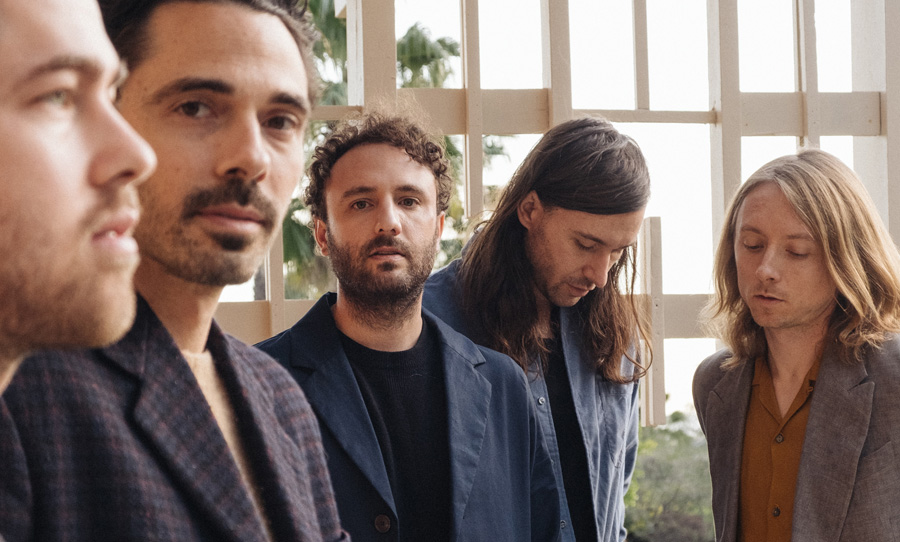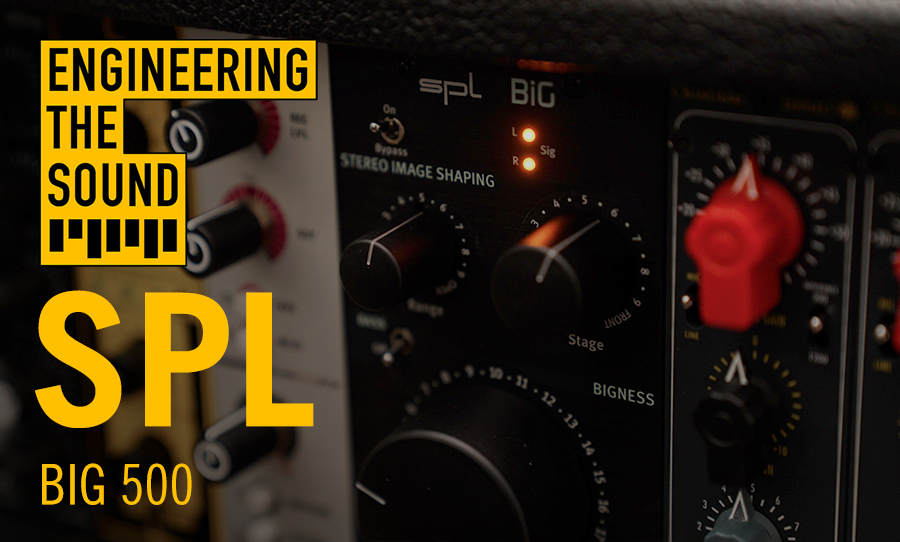As Kelcey Ayer tells us, the idea of a ‘band’ is fading away in favour of solo artists and chief songwriters leading their live bands. The case can certainly be made – and if you subscribe to that belief, Local Natives are more essential than ever.
Their fourth studio album Violet Street, out today, is the result of them embracing the essential aspects of their band dynamic – instinct and chemistry – more than ever. The result is fiercely engaging; a rare record in which the members’ cohesive character positively shines.
Before the album landed we sat down with Ayer to find out more about Violet Street, the wacky studio magic that brought it together, how Local Natives have changed since their genesis, and more.

We caught up with Kelcey Ayer of Local Natives to chat about the in-studio zaniness which brought their new album together.
HAPPY: One of the very first things that came up when I Googled your name was a list of your favourite albums of 2018, which included Low, Against All Logic, SOPHIE, Jon Hopkins… basically bang-on my favourite albums of the year.
KELCEY: Hell yeah!
HAPPY: Good taste, my man.
KELCEY: Thanks! You too.
HAPPY: What does listening to these super intricate electronic albums teach you about songwriting for an indie rock band?
KELCEY: I don’t know what it is, it’s just being interested in other things that don’t sound like our thing. We’re four albums in and I’m usually listening to stuff that’s not indie, full band focused, and I think it helps adjust your brain to getting into other textures and other sounds. I definitely think that the further thing from what you do is going to be more interesting, like listening to that Low record it reminded me of Portishead’s Third record, really minimal but pretty brutal tones, it’s hitting you over the head or there’s many minutes of the same thing happening. It’s awesome. I don’t know, Local Natives is such a beast with many heads, or something, and everyone listens to all sorts of different stuff but I would say… more stuff outside of what you’re comfortable doing in your own work is what makes me excited.
HAPPY: Are you somebody who goes really deep into listening to your own work while you’re recording? As in listening to nothing but those recordings, and those demos.
KELCEY: I’m sure other artists are similar, when you’re really deep inside of an album you’re making, you kind of turn the spigot off for new music coming in. I don’t know if it’s that you don’t want to subconsciously take from something… I just find myself not super interested in other music at that point and really digging in to whatever we’re doing. I can definitely say that’s a through line for all the records I’ve been a part of.
HAPPY: Cool.
KELCEY: I think as far as contemporary music is concerned, that happens. I do think a lot of times I’ve gone back to much older things when we’re really getting going on a record.
HAPPY: To speak about Jon Hopkins for a second, he’s come out and said that the reason his last album was so intricate was literally a huge amount of automation, and he’d spend hours tweaking the tiniest phrases. Do you find yourself going that deep into your own songs?
KELCEY: It’s funny, with this album I’d say we got the furthest from that. Whereas I think on the first few albums we’d always been of the mindset of ‘let’s demo everything out before we go into a studio’, because studio time is so expensive and we weren’t at a spot where we could be creative in a high pressure environment. So we focused on every single part that every member is playing, and on this record we wrote for a few weeks in Mexico and caught some moments on iPhone recordings, but we didn’t demo anything else and we took all that to Shawn [Everett’s] studio here in LA, and started from scratch with all that stuff.
We really tried to get out of our own heads and see what would happen if we could just feel the vibe of the room, and Shawn would just capture these magical moments that we would piece together. There’s a lot of songs that may be one whole take or a few different versions, but then we would patch work everything together. I think we really got out of our heads on this one, which really made, I think, some of our best work. I think we can be very guilty of overthinking things, and I think that there’s a magic that gets strained or suffers when you go over something over and over again.
HAPPY: Is Shawn’s usual modus operandi seeing what comes out of the room during studio time?
KELCEY: I think he’s different for every artist that he works with, like The War On Drugs dude, Adam, that’s a lot of just him so they’re kind of piecing stuff together. But the nature of us being a band who’ve played a lot together live, it was a conscious choice on this record to go back to that and recapture that. I feel like on the last record we tried to do things more on a producer level where we were tweaking tones and making demos of songs by ourselves then showing each other, which got some cool stuff out of it, but this time around it feels like it’s more and more of a rarity to be a band these days.
And we’re thinking that so much. Why would we walk away from that? Why not embrace who we are and embrace a thing that in 2019 is really unique now… which feels really odd to say. It’s always been people playing music in rooms and now it’s so much different. So that’s what made us want to do lots of stuff live, and play off each other live. I think Shawn is just a brilliant genius mastermind who takes whatever you give him and just runs with it. He really helped us elevate our musicianship to a point that we did not realise we had.
HAPPY: That idea of the band going away is pretty interesting. In the last five years I’ve found out so many of my favourite ‘bands’ are essentially one person acting as a chief songwriter. You could really make a case for that.
KELCEY: I didn’t even account for the fact that it still feels like the five of us are still very cohesive and still all doing stuff. I know what you mean, I guess we’re thinking of festival bills where hip hop, pop and electronic music… it’s interesting that these teenagers are growing up now like ‘I don’t care about guitars and I don’t care where it comes from’. They don’t care if it’s sampled live or if you play it live, they just want to feel something. And I think that’s rad, but I really do believe there’s a special quality to people that are actually there, like physically present. You can tell the difference. I’m not trying to be an old man (laughs), I’m just analysing I guess.
HAPPY: I read that you did a lot of tape loop stuff that you were physically cutting up with your hands. Was that another way to call back to that classic recording feel?
KELCEY: Yeah, I mean we did so much stuff on tape. I remember on When Am I Gonna Lose You we wanted to do this looping outro thing and Ivan, who engineered the record, with him we were cutting up tape and cutting out little windows for five days or something. And we put it together and listened to it, and it was like 15 seconds. We were like ‘oh shit! That’s not very long!’ It’s the sort of thing you could do on a computer in 30 seconds, but I do think it never would have sounded like it did without doing it on tape.
There was a bunch of fun little things we did. That was semi-traditional, but we did a lot of stuff that I guess was a harder route. We would do this stuff on purpose to see how it influenced the sound. While it took way longer, so many amazing things happened, so it was really eye-opening. It was a really fun way of doing things – super rad.
HAPPY: Can you give an example?
KELCEY: We have a song called Megaton Mile. We did this like Brian Eno did with Talking Heads, we took this ginormous loop of tape and ran it around the room using mic stands to hold it as it was going out of the machine and around the room, so that it was one huge loop. Then everything’s on faders and we’re live mixing everything as it goes in and out.
At one point I think Shawn got on the reel-to-reel and – like how a DJ scratches – he was doing that with the tape and it was warping it to some rhythm, it kind of sounded like cheesy DJ scratching. And there was this other time where we took a bunch of beer bottles and smashed them into a trashcan and recorded mashing all the bottles, then we put them onto an empty sampler which kind of looked like a Kaoss Pad.
HAPPY: I know the one.
KELCEY: So we were doing that with the glass and creating new beats for the outro of one of the songs, and that was very fun and eye opening.
HAPPY: That’s pretty sweet. Reminds me of Bobby Gillespie hitting trash cans on The Jesus & Mary Chain’s Psychocandy.
KELCEY: Shawn just kept coming up with… at a certain point I got kind of annoyed because I just wanted to do something normal and we never did anything normal. Every time we started a song he’d just be like ‘well, what if we take everything and put it in the sampler?’ I just felt like, damn, let’s just do a simple thing! But everything he did, 95 percent of the time, it ended up being way better. After I while I was just like, I need to shut the fuck up because everything we’re doing is ending up sweet.
HAPPY: Sounds like you’re already looking back on it fondly.
KELCEY: Oh yeah. Everyone was so stoked, I don’t think we’d worked with a producer in that capacity before – I think we can have trust issues working with people. We’ve just gone so long with the five of us and we want to do what we want to do, it’s hard enough to have five cooks in the kitchen so it’s always been hard to bring in that sixth member to help produce. I think this was the first time where we really embraced the role of a producer, and we’re all so excited about it came out.
HAPPY: Super excited to hear it! Now just to close, how is your dog Tasha?
KELCEY: Oh she’s good! She’s sleeping, she’s been sleeping all day and I need to take her out for a walk.
HAPPY: Great to hear. ell that’s all I had, thanks heaps for the chat.
Violet Street is out now.



